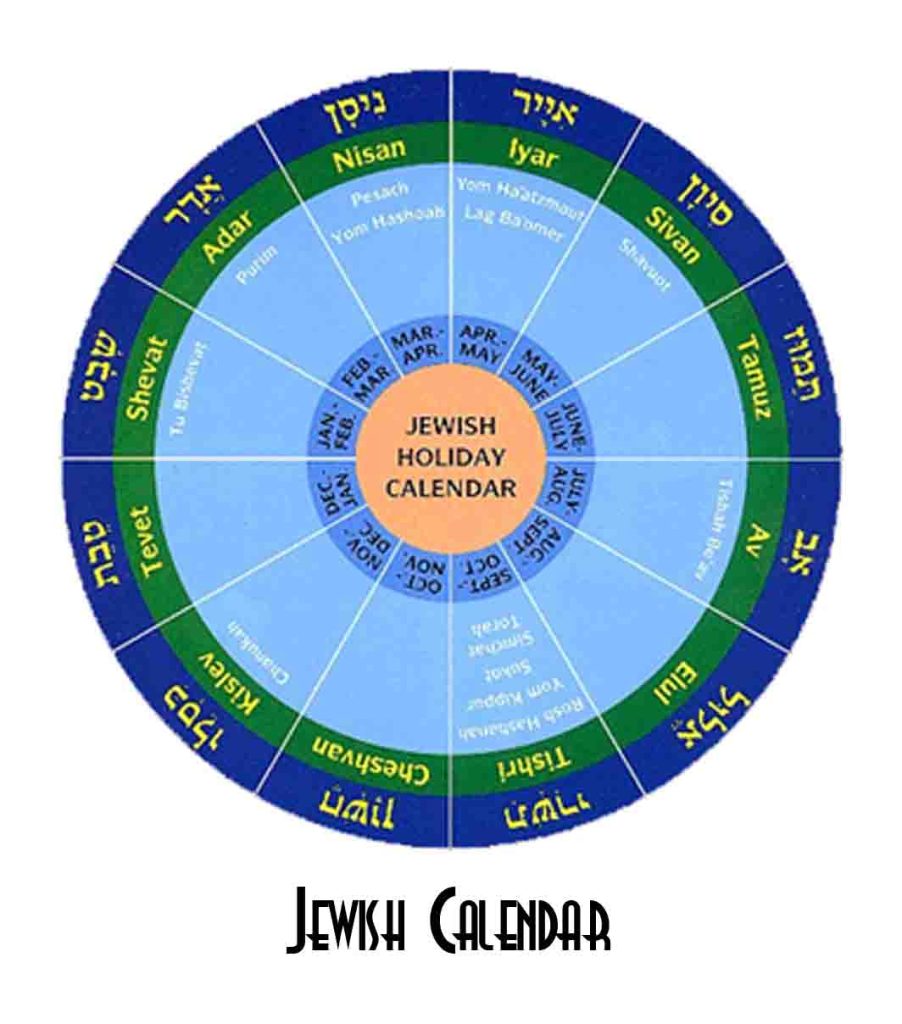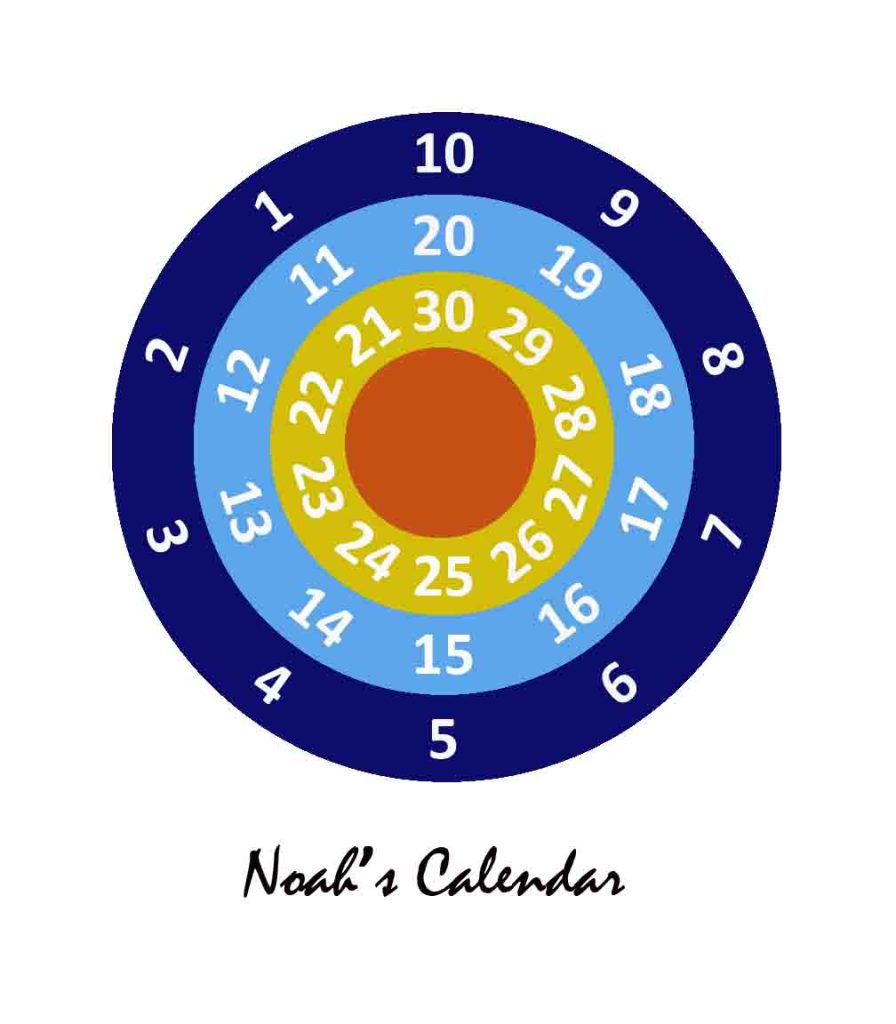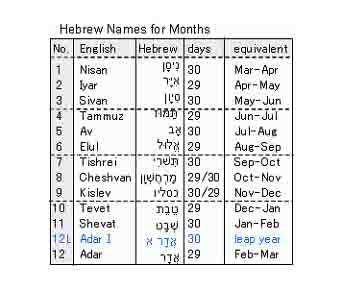52 Weeks in the Ark with Noah and Family (WEEK 9) – Times, Seasons and Noah’s Calendars
WEEK 9 (14-20 Tammuz, the 4th Month in the Hebrew Religious Calendar)
Was Noah using a calendar to record his Flood chronicles? When Moses wrote Genesis 7 and Jubilees 5 detailing the year, month, week and day Noah built and entered the Ark, was he making them up or did he use information that came from Noah himself who was also a scribe like him? Or did he get it from somewhere else? Moses does mention in Jub. 5:14 and 6:17 that the things he received in the Law were “ordained and written and engraved in heavenly tablets”. He did talk to Yah face-to-face. Moreover, Enoch talked to angels who wrote on golden tablets. So, if Noah and his family alone survived the Flood, then all records about his and Enoch’s life and works were the ones Noah carried inside the Ark and passed on to us to this day. It is a foregone conclusion then that Noah was using a calendar which Moses, with a few variations, was also using thousands of years later. What was that calendar? Where did it come from?
Before we answer those questions, we look at the meanings and the standards used to measure the “times” or “seasons”. In our high-tech era, the standards used for measuring time, weight, speed, distance and all other parameters are based on accepted fixed physical constants, such as the amount of atom in a perfectly-spherical Silicon-28 ball as the standard weight for 1 kilogram. The speed of light itself (distance over time) depends on standards for measuring distance and time accurately to the minutest degree. But all these began with Yah establishing the fundamental structure for physical matter to exist.
When light was created, Yah set the parameters for its existence — that is, its properties which scientists today study, measure and utilize. We can talk about brightness, heat, electromagnetism and quantum energy as just some major consequences of the existence of light, even without the Sun and stars still in existence. So, what was the speed of light before the Sun was created? Was it different? We do not know. For all these are inconceivable without a living body to experience or measure them.
That is probably why plants were created first before animals and humans. They processed light as life-giving food. Next came animals who feed on plant life. Finally came humans, to complete the framework for Yah’s revelation of His Divine Nature in Physical Nature. Hence, when He created the Sun, He also set the “times” and “seasons” to instill order and to provide standards for the operations of Creation.
We already said that Yah meant the Sun, stars and the Moon to be “for signs and seasons for days and years”. A sign (oth) is a “token”, “pledge” or “standard”. A season (moed) refers to an “appointed time or place”. The Sun and stars, then, are the signs or tokens for measuring the length of a year, the Moon the length of a month. A year is an “appointed time” or “period”, and so is a month. For the Earth revolves around the Sun in exactly a year, as defined by Yah. The Moon, as decreed, revolves around the Earth in a month. “Appointed” would refer then to that fixed moment or place when something will return to where it began, as the Sun or Moon returns to its former place after a year or a month, respectively. “A-pointer” in Old French means precisely that: from a point to a point.
How Day 1 to Day 3 were Measured
How then did Yah measure the “yom” or day from Day 1 to Day 3 when there was no Sun, Moon and stars yet? We go back to the beginning. When the Ruach of Yah moved or hovered upon the face of the deep, the plan for Creation was in contemplation or being prepared in the darkness. It all began when Light came into existence: Yehi Owr! Let there be Light! What was that light? Where did it come from? Where else but from Elohim — and Ruach, in particular?
Moving then upon the deep, this time, like a golden flame skimming over the waters, Ruach marked the passage of the “times” and the “seasons” according to the appointed, perfect standards of Universal Time. With the angels of Heaven, He must have laid down the passage of what would become time and the dimensions of the Earth. First then, He set the period of one day — the first evening and morning. Fast-forward to Pentecost Day, AD 33, we see Ruach again hovering over the heads of the disciples like tongues of fire, fulfilling the promised New Creation under the rule of the King of Kings in Heaven. The light Ruach manifested in Creation gave perfect, endless life. So was the light He delivered to the believers who were destined for eternal life.
After creating the firmament over the Earth, Elohim then set on Day 4 the celestial bodies that will bear the manifested light of Ruach for the operation of the Universe: The Sun, Moon and stars. That is, in the same way He would transfer the light of His Divine Nature upon human flesh on Pentecost, He manifested created light in celestial bodies that would then maintain the perfect “times” and “seasons” for humans and all living things.
But how do we measure time from Day 4, for example? Or from today till next year? The Sun has no visible fixed marks to help us measure a year. The relative positions of the near and distant stars, which appear motionless, can help us do that. Astronomers have been doing it for centuries. The changing phases of the Moon are easy to observe and to measure for each revolution – from New or Full Moon to the next New or Full Moon, respectively.
How Humans Learned to Tell the Time
Remember that in the beginning, the Earth had no tilt; hence, the day was as long as the evening, anywhere on the globe, except the poles, of course – it was always day. Because of that, there were no varying seasons as well. Seasons, as used here, has nothing to do with climate but to the “set” or “appointed” period directed by the celestial bodies. So, if you plant a vertical stick on the ground and observe its shadow on a wall or the ground, the shadow will always be a diminishing or lengthening straight shadow at the Equator. In the Northern Hemisphere, the shadow of the stick would move clockwise, giving us the origin of that term when mechanical clocks replaced sundials.
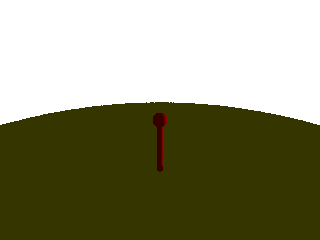
Based on this simple sundial tool, one can divide the duration of a day into 6 equal periods in the morning and 6 equal period in the afternoon – 12 hours for the day. Using the light of the Moon as it rises at 6 in the evening, there are 12 hours for the night. (Measuring angles by sight using tools can also be done accurately.)
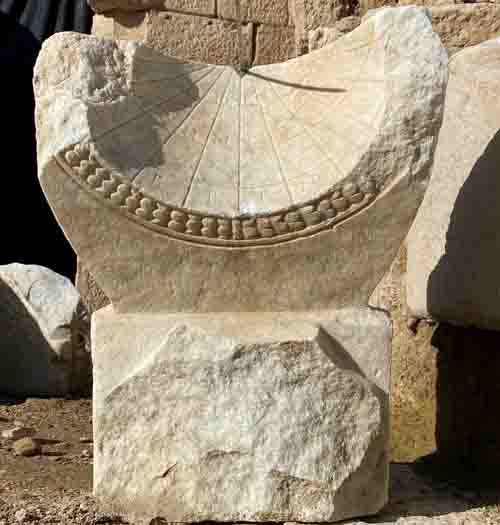
The Original 360-Day Calendar
From these simple measurements, we end up with 360 days to a year, 12 months to a year, and 30 days to a month. This is where the 360 degrees of the circle comes from. Each day then is equivalent to one degree the Earth has moved through its revolution around the Sun. Each month moves through 30 degrees. How convenient indeed: 1 day = 1 degree! You think mathematicians are so smart? They are because their Tutor is so much smarter!
We do have historical, geological and archeological evidences of the 360-day year. This is the original calendar used by Adamah up to Noah. Humans were not the only ones physically and spiritually perfect in the beginning. Even the Universal clock-mechanism of the celestial bodies was perfect. How could it have been otherwise? Yah meant it to be so and made it to be so, as He Himself had declared it. If the measurement of Universal constants discovered by scientists could be so precise and dependable, how could Yah’s Creation in the beginning be any less precise? Imagine Him saying, “I make the Sun, stars and the Moon as the Universal Clock to fix the time from now and henceforth. But pardon the erratic hour-hand; this is just a prototype.” Very unlikely.
But today, we only know and use a degraded or corrupted Universal Clock, and nothing else; hence, we think it has always been that way. Something happened to change the movement of the spheres sometime in the past. A cosmic and cataclysmic event did it.
Noah’s Calendar
Consider then a calendar wherein a year has 360 days, 12 months and 30 days each month. All these numbers are divisible by 1, 2, 3, and 6, which is a series of numbers obtained by adding all the preceding numbers to get the next number: 1 + 2 = 3, 1 + 2 +3 = 6. Note that a 30-day month is not divisible by 7 but by 6 and 5. So, where did the 7-day week come from? Many would say from the 7 days of Creation. But did Yah specifically define the week; or did He only mention that it took 6 days to create and that He rested on the 7th? Noah’s account in Genesis never mentions the week; however, Moses (who mentions himself as the writer in Jubilees) mentions the week in his account of Noah’s story.
Records show that the 7-day week was a latter development invented by the Sumerians and used by the Babylonians, and which the Jewish exiles of Babylon merely adapted. We must read Moses then as referencing Noah’s account using his (Moses’) calendar and the laws based on that newer calendar. The point is that all of Creation was finished in 6 days and Yah’s “rest and refreshing” came the day after. We are supposed to make that event as a “holy remembrance”. It could have been commemorated initially during each 7th day of the year or even every 7 years but not weekly or even monthly. It was a one-off event until the 7-day week became a Hebrew practice. It then became the official rest day or Sabbath Day, as established on Mt. Sinai by Moses’ Law for the Israelites.
Remember, the Sabbath Day was made a law for the Israelites as a covenant with Yah under the Law. The original declaration and command during Creation was merely for humans to hallow it or make it holy without a specific practice mentioned. Enoch and Noah never mentioned such a practice, except as a vision of future events. Enoch and Noah themselves knew Noah (REST) was the rest they had been promised to be given. That rest would come not in a ceremonial or ritual event but a cosmic event that will rest, refresh and reset the whole Creation. Moses, on the other hand, was receiving a law that would give the Hebrew slaves rest from their labors in Egypt. From working unceasingly as slaves to having a regular rest, they had entered into a covenant and come under the merciful rule of a loving Savior.
Today, a majority of the Christian population does not practice the weekly Sabbath-Day stoppage from work. It has been replaced by Constantine’s Sunday Law, replacing the 7th-day rest with a Sunday rest. And many believers consider this as the fulfillment of apostolic examples when they “met and broke bread” on the “first day of the week”. Moreover, they consider the Sabbath Law as a covenant between Yah and Israel, not with the rest of the world. Nevertheless, many Jews consider Sabbath as more important than the other Jewish Feasts. But if the Law had been fulfilled on the cross by Yahusha, so was the Sabbath; that is, He gave believers the genuine rest and refreshing Isaiah prophesied. Nevertheless, there is the final rest and refreshing still to come. This requires another discussion later.
We find then no reference to an appointed day of rest before the Law of Moses as a divine decree or religious practice. Moreover, except for Sabbath, days were not even given names before the Babylonians, Egyptians, Greeks, Aztecs or Mayans began the practice. (Ex. 31:12-17) In all possibility, the decree of a rest day was not just an application of a divine-work example on how we should see human labor, but also a prophetic word for the eternal plan He had intended for humans and all Creation at the end of the final year, final month and final day.
Days of Noah/Rest Defined
Enoch named Noah, saying “he will give us rest or comfort from our labors”. As such, to “hallow the Lord’s rest” means more than rest from work. It is the fulfillment of a purpose and completion of an objective. It does not mean avoidance of our essential existence as creative agents. You finish a task then allow that completed work to remain as is and thrive and grow in abundance. The work came from a human’s efforts and will remain his or her ownership. Resting from work is not merely enjoying rest or doing nothing or wasting time, but living with fullness and abundance in our blessings, including the fruits of our labors. The products we derive from having done work, whether material (example, food) or spiritual (praise or honor or thanksgiving), make rest worth doing as well.
Noah’s rest pointed to Earth’s rest from wickedness. Peace, joy and abundance reigned after the Flood. Abraham’s rest came from being finally separated from idolatry and sinfulness of one’s relations. The Hebrews’ rest came when they rested from slavery in Egypt. Israelites rested when they had escaped the hardships and the effects of sinfulness in the wilderness. Judah rested and returned from exile in Babylon. The believers in Jerusalem rested from sin and from the Law through the pouring of Ruach on Pentecost Day. Whether one celebrates that rest as a religious tradition or a divine, personal gift given to all, the important thing is to “make it holy or sacred” as part of one’s acceptable offering to Yah.
Even the perfect Creation of Yah will have a rest and refreshing when the New Heaven and New Earth will come at the last day. In keeping with the 7-day, 7-week, 7-year cycles or jubilees Yah used in His dealings with His people, the last day is expected by many to come at the end of the divine “7-year” of 7,000 years (a thousand human years for each divine year). And based on the counting done by using the Hebrew calendar, the current year is 5,784 as of this writing. Based on the Mayan calendar this year is 5,136. Does this mean we practically have less than “one divine day” or less than 1,000 years left for this Old Creation to expire? The way things are, many would not mind for it to end tomorrow. Could we then be in the prophesied “Noah’s days”? It seems we are, literally. We will show why.
Noah’s 30-Day Month
How sure are we that Noah used a 360-day calendar? We recall that 7 days after Noah and his family brought all the animals aboard the Ark, the Flood began on the 17th day of the 2nd month of Iyar. (Gen. 7:7-11) Five months after (150 days to be exact, according to Noah’s log), the waters subsided on the 17th day of the 7th month of Cheshvan. (Gen 8:3-4) If so, Noah could have used then a calendar that looks like this one:
| 1 | 2 | 3 | 4 | 5 | 6 |
| 7 | 8 | 9 | 10 | 11 | 12 |
| 13 | 14 | 15 | 16 | 17 | 18 |
| 19 | 20 | 21 | 22 | 23 | 24 |
| 25 | 26 | 27 | 28 | 29 | 30 |
In a 30-day calendar, as shown, a 6-day week is more organic and practical than a 7-day week, for several reasons:
- You get 5 weeks of equal length, easy to count with the 5 fingers of a hand.
- Each day reminds you of the corresponding day of Creation. In fact, if we have to give a name for each day, it should be: Light Day, Firmament Day, Land-Plants Day, Celestials Day, Animals Day and Humans Day.
- You start and end each week in-synch with the Creation week.
- Based on the above, Yah’s rest day or the 7th day will fall on the first day of the second week. And if one wants to celebrate every 7th-day, then it will be on the 7th, 14th, 21st and 28th. Unlike in the modern calendar, the day-numbers do not change.
- We only need to reuse this monthly template 12 times a year, perhaps, using a peg to mark the day. Months can be marked off using numbers 1- 12 on top of the calendar.
Perhaps, this seems artless and mechanical to many of us. And this may not necessarily have been the real practice then; but it shows us how it could have been, based on the divinely-given parameters in the beginning. We follow only the designs, the structures, the purposes, the intentions and even the mathematics of the Creator. Changing them has grave consequences.
An Alternative Noah’s Calendar
But why a rectangular calendar, which is awkward? It could have been a circular calendar similar to the one the Mayans and Aztecs used or the Jewish calendar on top. Notice that the clockwise movement of the Sundial and the modern clock is actually counter-intuitive to divine patterns. This is due to the fact that the Earth rotates counterclockwise as seen from the North Pole. People see the Sun in the Northern Hemisphere moving clockwise; but those below the Equator see it move counterclockwise. Thus, it should not be the Sun or the Moon that dictates the direction of the Earth’s movement but the Earth’s movement itself. For it even revolves around the Sun counterclockwise, again seen from the North. Thus, the Baktun Cycle of the Aztec Calendar rotates counterclockwise — right to left upward, as the Earth moves. The Hebrews write from right to left, giving basis for the divine pattern in Creation.
Below then is a proposed alternative Noah-calendar month of 30 days that is read counterclockwise. It has 3 rings of 10 days each and provides a friendly way of reading and following the days of a month, as each spoke of 3-numbers is a series with a difference of 10. Just like Noah’s days, it has no names for days. Remember that Enoch, Noah and many of the prophets wrote the time simply by mentioning the Nth year, the Mth month of the reign of King X; even on the Kth day or so. It was only later when months were given names. In the 1st century, they only had Sabbath Day with a name (it was a counting name, as the root word for Sabbath means 7). The Romans, as we know, gave the names of their gods and goddesses for months. Later on, someone added the names of Nordic deities, such as Thor and Woden, as well as the names of celestial bodies, such as the Sun, Moon and Saturn. All of which signify the handiwork of those who practiced dark angelic secrets, such as sorcery, magic and astrology.
Freedom from Idolatrous Worship and Traditions
Using Noah’s simpler calendar will set believers free from these idolatrous names. The question now is: How can we us a 360-day calendar when there are 365.25 days in each year? Easy actually. Just like the ancient people, whether Egyptians, Ethiopians, Greeks, Romans, Mayans or Hebrews, we add 5 days each year and another day every 4 years (leap year). These additional 5 days-or-so are literally “Noah’s Days”! He was the first one to live through them and to record the fact for posterity. He and his family were in the Ark 365 days! Yes, he had an old calendar; but he only needed to add 5 days because that was the result of the cosmic, cataclysmic event we call the Great Flood. Why make the wheels of a cart bigger to reach your destination if you can travel the same distance with a smaller wheel?
Historically, the Romans, the Mayans and the Egyptians considered the additional 5 days as bad luck or ominous days which they spent indoors (for some, another month or more were added, according to their year-base, e.g., 260 days). That led to the added days (or a 13th month) of 5 days being seen as a bad time of the year and which the rulers then turned into festive celebration to dispel the winter gloom. Hence, when the Julian Calendar was established in 45 BC by the Romans, it was not only to replace the Lunar Calendar they were using with the Egyptian Solar Calendar but also to update the “new appointed times” for planting, harvesting and their feast days. (Remember, in the days of Adamah up to Noah, it was endless spring!) They were off by months by that time. But the Julian Calendar remained inaccurate and was eventually replaced by the Gregorian Calendar in AD 1582. As of now, the two calendars are 14 days apart; therefore, some Orthodox Catholics use Julian, some the Gregorian Calendar. Christmas in the Julian Calendar falls on January 7, while in the Gregorian Calendar, it is December 25.
It appears that one of the major considerations for using the Gregorian Calendar by the majority of Catholics was related to Christmas Day. December 25 had become the joyous culmination of the yearly ecclesiastical rites which had originated from an ancient, Roman pagan-feast called Saturnalia. That day marked the Sun’s return after the winter season. The Church appropriated or “christianized” Saturnalia and turned it into Christmas, the supposed birth of the Savior. The gift-giving and feasting have remained essentially the same.
This explains many of our cultural traditions. But the one thing we have forgotten is how those 5 days came about and what they truly mean to the Earth, to history and to us humans. The final 5 or 6 days we spend each “last days of the year” are literally “Noah’s Days” which we spend in merriment, revelry or dissipation, full of commercialism and riotous excesses which are ironically reminiscent of the behavior of those who drowned during the Flood.
Earth’s Expansion in Mythology
Geologically-speaking, the expansion of the Earth either caused the slowing down of its rotation or moving farther from the Sun, thus, adding 5 days to each year. Likewise, the Moon may have moved closer to the Earth or moved faster since the month became 29.5 days instead of 30. These cosmic changes are even preserved in one of Egypt’s old myths where the sky-goddess Nut married the earth-god Geb against the sun-god Ra’s wishes. They were separated even though Nut was already pregnant and was also prohibited by Ra to give birth in any month. Thoth, the god of wisdom, came to her rescue by playing the game Senet against the Moon who lost and created 5 more days in which Nut gave birth to 5 children. Since the Moon used part of its light in order to create those 5 additional days, it had to suffer diminishing light but gaining it back, and so on through waxing and waning.) The picture of Nut, who was also the twin sister of Geb, becoming pregnant cryptically shows the Earth and the sky expanding together and gaining 5 days more in reality, as we have posited.
Now, we know myths have real historical basis. So, why would Egypt have a calendar of 360 days sometime in the past and then change it into 365 days? And so with many other nations we have mentioned and which all have ancient narratives of a global flood as well. Coincidence would be a fool’s or an intellectually-dishonest person’s explanation to all this.
In Jubilees, Moses says that when Noah started building the Ark, it was on the New Moon. When they entered the Ark, it was on the New Moon. The New Moon, marking a new season or period, signifies a beginning: here, the act of saving and the act of judgment. It marks the start of a month of 30 days, or even a year of 360 days and 12 months. The Lunar Calendar worked previously because it was perfectly in-synch with the Solar Calendar; but after the Flood, the Universal Clock was out-of-synch. Hence, although Noah entered the Ark using a 360-day year calendar, he came out using a 365-day calendar! The rest is history, as they say. No, for Noah, his rest is history! Or, History begins and ends with Rest.
The Hebrew and the Ethiopic Calendars
Before we end, let us compare two prime examples of how Noah’s Calendar had evolved and yet remained embedded in the present world. Today, the Hebrew Religious Calendar looks quite different from Noah’s Calendar and from the Gregorian Calendar, as shown below:
It has 353 days and 354 days on a leap year. Since this is a Lunar and Religious Calendar based on the Moon’s 29-day-or so cycle, it does not jive with the Earth’s revolution around the Sun, hence, the discrepancy. On the other hand, the Solar Calendar based on the Sun’s movements has 365 days. The Sumerians, Mayans, Egyptians and Aztecs have both calendars, as they were all Sun and Moon worshipers and depended on the behavior of celestials bodies to mark their rituals, agriculture and daily life. In order to remove the discrepancies, the Lunar-Solar Calendar was used, merging the two to correct the missing days by adding days and months.
When the Romans finally did away with the older calendars, they instituted their own form of devotion to their gods and their way of life. And like the Egyptians, they celebrated the last 5 days with festivities. Here is the Ethiopic Calendar, including notes as to how the rest of the civilizations relates to it:
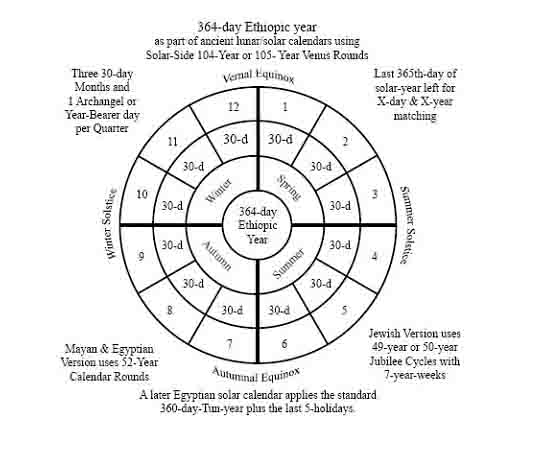
Note how the days or months are not given names. Each month has 30 days (retaining Noah’s organic month), but the total number of days in a year is 364. Finally, this calendar marks of the precise changing of the seasons in relation to the passage of days and months. We may have to update our counting of Noah’s journey based on this fresh discovery or revelation from history, since we have been using the Hebrew Religious Calendar. We learn a new thing daily as we seek the Truth!
Conclusion
This lengthy research and discussion hopefully clarifies all our confusion and unawareness of what happened back in the time of Noah and the millennia after that and even up to the present. Unpacking all the information we get online can be daunting; however, the enlightenment and the realization we gain from what Yah did for humans, how humans changed His decrees, and how the prophets served to refresh the original or organic ways give us the tools to live and avoid the errors done in the past.
The time is short. No, Yah promised to shorten the time, in fact, on behalf of His people when the wicked one will come to devour His Creation. If Yah can make time and order the Universe according to His wisdom and power, He can surely shorten time. Why? Because once upon a time, He lengthened time during the days of Noah. Does it mean he will restore things to their former ways? Or will He stop time itself and refresh His Creation and bring about New Times and New Seasons that will be everlasting? Our faith and hope tell us He will.
Notes:
1If one faces the Sun while standing on the side of the shadow, the movement of the Sun will also be clockwise.
